Luanne Rice's Blog, page 5
June 26, 2017
Video Trailer for THE BEAUTIFUL LOST
I'm happy to announce the video trailer for The Beautiful Lost is now live!
(Directed and produced by Trevor Clark Thalin--who also directed the award-winning film Baby, based on the novel of the same title by Joe Monninger.)
Playlist for THE BEAUTIFUL LOST

While writing THE BEAUTIFUL LOST I listened to lots of music. So did Maia and Billy, on their road trip to find her mom. In some cases the songs overlapped. I wrote a guest post for The Book Beacon, and talked about the playlist there. And you can read it here:
Playlist for THE BEAUTIFUL LOST
Maia and Billy are on a road trip to find her long-gone mother in a rusty red truck with an unreliable radio. Needing not to be found by her frantic dad, they drive on back roads through the New England and maritime Canadian coastal boonies, turning the dial to college stations that fade in and out. They’re both fighting demons—Maia’s depression and Billy’s dark secret—and the songs provide a soundtrack that brings them closer to each other when actual words are too hard to say.
I listened to music while I was writing the novel, and these songs carried messages and meaning that I imagined (or in some cases, wrote about in THE BEAUTIFUL LOST) Maia and Billy would take to heart.
Wagon Wheel— Old Crow Medicine Show
This exuberant song requires your heart to lift. It encourages you to sing along, even if you don’t know the words. And if it makes you stop and dance by the side of the road, so much the better.
Mercy of the Fallen— Dar Williams
This song breaks and heals my heart. It’s so full of compassion and longing. A singer-songwriter friend told me it’s about the kindnesses touring bands and musicians show each other along the road. That seemed apt, considering Maia and Billy’s huge need for kindness. In the book, this was one of Maia’s mother’s favorite songs.
Born to Run— Bruce Springsteen
1) Two kids getting out of a small town.
2) One of my favorite lines in any song: “I want to know if love is wild/Babe, I want to know if love is real.”
3) And because deep down we all want to be Wendy.
I love both versions. I didn’t think anyone could perform “Lovesong” better than The Cure—it’s from their 1989 album Disintegration—but then I heard Adele’s track. She slows the song down, adds layers of desire and heartbreak, and works the melody straight into your soul. The line “I will always love you” pretty much says it all. It could be sung by Maia to Billy or to her mother. Or Maia’s mother—in spite of the fact she abandoned her daughter years ago—could be singing it to her.
Bells by Maesa Pullman and Rosa Pullman
I adore this song and these singer-songwriters (who also happen to be cousins.) The music is so lovely, the harmony sweet beyond belief. It starts with the lines, “Once we make it through the storm/We’ll rest, rest upon the shore/You and me in a sea breeze/Making me weak at the knees.” So there’s that...
And then, this part kills me: “Don’t try to analyze the storm/It’ll come and then it will be gone/You can’t put it in a bottle, seal it up/ ‘cause then there will be trouble.”
What perfect lyrics for Maia, a girl who’s been so depressed she’s wound up in the hospital because bottling up the storm—the despair and rage she felt over her mother’s leaving—took her so far down and, yes, “then there will be trouble.” But the song is titled “Bells,” jubilant for a good reason, reminding us there’s life and goodness after the storm.
Down by the Water— The Decemberists
This is a song of Billy’s. It’s forlorn but defiant, and I hear sorrow and yearning in the harmony. I am big fan of the band—I love Colin Meloy’s lyrics—and this song hits me especially hard because Gillian Welch sings on it and she is so far past amazing it can’t be quantified. The water imagery, the mention of a seaport (Mystic Seaport plays an important role in the novel,) the harmony (I’m thinking of Maia and Billy as well as the actual singers,) make it a song they had to hear along the road.
This beautiful, haunting song ends with the line “You’ve got to hang on to yourself.” Isn’t that so, so true, the lesson we all have to learn? Leading up to it are lyrics sung by someone who notices and cares. He sings, “It’s all in your face/I see you break/It’s like the sound of winter.”
That’s what depression is like: endless winter. And I love the song, written by Gavin Rossdale, because it understands that fact. I think that everyone who’s ever been depressed knows how frozen we can feel, and how welcome and surprising it is to feel someone notices, really sees, beyond the fake emotions we show the world to make people think we’re okay.
Something else about this song—my friend Chris Traynor is lead guitarist in Bush. Chris understands darkness and writes about it very well. We are writing a book of poems together. He’s a great light in the world, but isn’t that often the way? We see what is light in life by not being afraid of the dark.
The video for “The Sound of Winter” was shot partially on the beach in Malibu, California while I was living there. Chris, his girlfriend Sibyl Buck, and their daughter Puma appear in the video. I love watching it and seeing them. It has a vibe of happiness and togetherness, the band in the studio and onstage, friends and family on the beach.
It reminds me: You’ve got to hang on to yourself.
June 18, 2017
THE BEAUTIFUL LOST Book Tour 2017
Coming soon to a bookstore near you: ME! I will be talking about THE BEAUTIFUL LOST (out 6/27) and would love to see you along the way. Please stop by one of these great stores/libraries and say hi. Also, i could use a hug--can't you?

The Beautiful Lost tour schedule
June 10, 2017
World Oceans Day
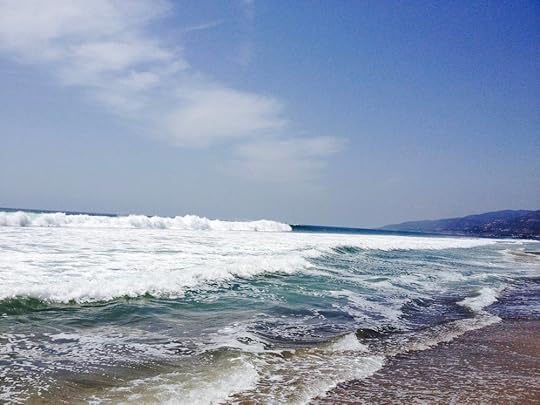
The ocean gives me life and inspires all my books including THE BEAUTIFUL LOST. Thank you Scholastic for featuring my World Oceans Day essay on the Scholastic blog! You can click on the link or read it here:
Celebrate World Oceans Day with bestselling author Luanne RiceBrooke Shearouse June 8th, 2017
It’s World Oceans Day, and to celebrate, author Luanne Rice stopped by OOM to talk about her connection to the sea and answer our questions about her newest YA novel, The Beautiful Lost. Her latest is a sweeping story of a girl and boy, both troubled in different ways, who take off on a whirlwind road trip up the East Coast. Check out the chat below to learn more!
How did your connection to the ocean start?
I was very lucky to grow up spending every summer at my grandmother’s house at the beach. School would get out in June, we’d pack our bathing suits and Scottie dog into the station wagon, kick off our shoes, and basically not put them on again until September. My sisters and I spent every day on Long Island Sound. I was inspired by sunlight and moonlight on the water, whitecaps, constant wave action. My first published story, when I was fifteen, was about an adventure with my cousin at the beach.
I spent most days playing in tidal pools, learning to identify species of fish, crustaceans, mollusks, starfish, jellyfish, and barnacles. It was so mesmerizing, hours could go by. I observed how tides and currents brought energy and nutrients into the pools, how different kinds of seaweed could be used as camouflage and habitat for hermit crabs, periwinkles, cunners, molting lobsters, and other creatures. Those days taught me so much about the ecosystem and made me want to know more about the ocean environment.
My friends and I bonded over love of the sea. We’d swim out to the big rock and around the point, go on marathon expeditions with a flotilla of rowboats, and hike through the woods to a secret beach and wait until after dark to take night swims and watch for shooting stars.
For my eighth-grade science project, I used the family Super 8 movie camera to make a short film about local water pollution, At fifteen, my summer job was helping my father pull lobster pots, and at nineteen, I went to study humpback whales aboard R/V WESTWARD, a hundred-foot staysail schooner, run by the Sea Education Association of Woods Hole, Massachusetts. One of the great joys of my life was being surrounded by oceanographers at the famous Woods Hole Oceanographic Institution and Marine Biological Lab, studying through the night in the MBL library, with the boats in Eel Pond just outside the window, the music of halyards clanking in the wind.
What is The Beautiful Lost about and what role does the Atlantic Ocean play in story?
The Beautiful Lost is about a girl named Maia, who goes on a road trip up the East Coast in search of her mother. Maia’s mother left the family for her career as a whale researcher in a part of Canada so remote, it’s off the map. Her mother’s leaving triggered severe depression and sent Maia to a psychiatric hospital. Maia struggles with continued treatment, the unwanted effects of medication, feeling different at school, and the constant pain of missing her mom. A shining light in her life, literally, is the glowing window of a group home on a distant hill, where a boy named Billy lives. Maia has a secret crush on him. When she decides to take off to find her mother, she drives up to the home for one last goodbye, and Billy shocks her by jumping into the car and telling her he’s running away with her.
Billy plots a route for them through coastal New England. The first stop is Mystic Seaport, where Maia finds a very old, valuable bookthat contains the information Maia will need to find her mom. Billy and Maia stop in Atlantic fishing villages, libraries by the sea, and a lighthouse on the easternmost tip of Maine. By the time they reach Maia’s mother’s research station on the St. Lawrence Seaway, they’ve worked in a crab processing plant, traveled on ferries and a fishing boat, and seen countless beluga and humpback whales.
The ocean brings Maia and Billy close together. It also pulls Maia to her mother. Along the road trip, Maia feels the power of the ocean and discovers a life force and strength within her she hadn’t known was there.
Would you say the ocean inspires all your writing in some way?
We are made up of salt water—tears and blood. Nothing in life—other than love and my relationship with my sisters—has inspired me more than the ocean. It has found its way its way into almost all my books. I’ve written my novels on the edge of various coasts: overlooking the Pacific from a bougainvillea-covered bungalow in Malibu; watching a fleet of vintage 12-Metre sailing yachts crisscross the harbor in a graceful maritime ballet from my desk in a borrowed stone carriage house in Newport, Rhode Island; nestled into a bed-and-breakfast above the Celtic Sea in Cork, Ireland; at the Wonderview Cottages by the seal-filled bay in Belfast, Maine; and, especially, at the old oak table in my grandmother’s beach cottage in Connecticut—the place I’ve come every summer of my life, and am now lucky enough to own.
How can readers help the world’s oceans?
Spend time by the water, learn about everything you can, fall in love with it. Tide pools can teach you so much. They can be very small; one of my favorites is an approximate two-by-three-feet cut in the rock ledge jutting into the cove, and it contains so much sea life. I encourage you to try it—just stare at the smallest area and be amazed by what you see. The great thing about the intertidal zone is that it doesn’t reveal everything all at once. You think you’ve seen all the mussels, whelks, starfish, and minnows there are to see, and suddenly a wave ruffles the chondrus crispus seaweed bed, and a rock crab will scuttle forth. Am I an ocean nerd? Obviously. But try it, you’ll love it.
Another way to help is to reconsider balloons—they look pretty and festive going up into the sky, but when they fall into rivers they are borne to the ocean where creatures from sea turtles to whales mistake them for jellyfish or other food, ingest them, and die. The same is true of all plastics—bags, utensils, anything that might find its way to the sea and into the food chain.
My bookshelves are full of volumes about ocean science and conservation, some classics, others new. I love novels with seaside settings. Any book—fiction or non-fiction— inspired by the sea can instill or encourage a love of the ocean, a protective feeling for the environment, and that can only help.
Non-fiction:
The Sea Around Us by Rachel CarsonUnder the Sea Wind by Rachel CarsonRachel Carson: Witness for Nature by Linda J. LearThe View From Lazy Point by Carl SafinaThe World Is Blue: How Our Fate and the Ocean's Are One by Sylvia A. EarleGrayson by Lynne CoxHow to Read Water by Tristan GooleyYoung Adult and Middle Grade Fiction:
Sea Change by Aimee FriedmanIsland of the Blue Dolphins by Scott O’DellMisty of Chincoteague by Marguerite HenryRockall by Amelia Onorato (a graphic novel by my niece—full disclosure!)Nightbirds on Nantucket by Joan AikenWish by Joseph MonningerFlush by Carl HiassenAnd here are some websites to check out:
Sea Education Association Oceana National Geographic Ocean Education Surfrider Foundation Natural Resources Defense Council The Whale Route ( a website about the area of Quebec where part of The Beautiful Lost takes place~)May 26, 2017
The Beautiful Lost: Depression and Road Trips With Cute Boys (review by SKG fun)
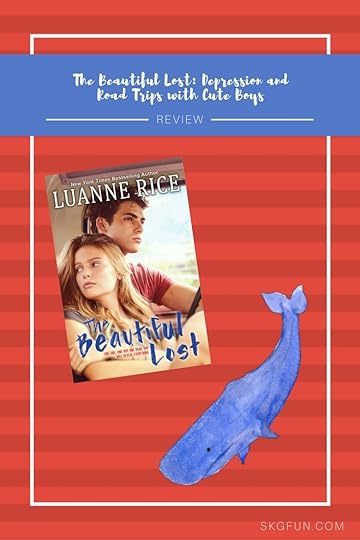
thank you skg girl for this lovely review of THE BEAUTIFUL LOST!
reposting from SKG fun:The Beautiful Lost: Depression and Road Trips with Cute BoysPosted on May 22, 2017AmandaPosted in Books, Reviews
The Secret Language of Sisters? I looked at the book my friend Julia Findley had sent me. Looks good.
Looks good was an understatement. Not a week later I was flipping the last page, my heart torn into three bajillion pieces, a warm feeling floating all over me.
At that moment, I promised myself I would never text and drive. EVER. (You’re gonna want to read this book too!)
Imagine how pleased I was when I discovered Luanne Rice, author of Secret Language of Sisters, has a book releasing in June of this year. But I never imagined she would actually send me an Advanced Readers Copy!! SO Y’ALL . . . I GOT MY FIRST ARC!
This book is called The Beautiful Lost, and we’re partnering with Ms. Rice in a few weeks to give ONE OF YOU the chance to read it.
But first!! Review time!!
-MY RATING-
A brilliant 4.296 stars.
-AN ENTERTAINING ONE SENTENCE SUMMARY-A girl embarks on a road trip with her crush (who may just be as nutty as his murderous father) along with lots of snacks and together they start on a mission to find the girl’s marine-loving mother and put her life back together again but oops they might just fall in love.
-MORE ENTERTAINING SHORT SUMMARIES-
Whales. SO. MANY. CUTE. WHALES.
Libraries.
Billy who is just goalz with his freckles and green sparkly eyes.
Beat-up cars with super-cool stories yaaaaaass
THE FRENCH. Bonjour.
Dancing lobsters!!
FOOD.
A scary lack of money (NO, BOB, WHATEVER SHALL WE DO??)
BREAKING ACROSS BOARDERS MUA HA HA!!
-SLIGHTLY LONGER SUMMARY-
It’s been three years since Maia’s mom ran away to devote her life to studying whales.
May 14, 2017
Night Stories

Save-A-Lot, oil on linen 36 x 36, story by Anthony Doerr
Linden Frederick is the most literary of artists. His paintings tell stories by inviting the viewer into a very focused and specific moment in time, engaging our imaginations. He often paints night scenes: dusk to dawn, changing light . He depicts houses, windows dark except one, making us wonder what is going on inside, drawing us into the family story. Sometimes there will be taillights on a highway, making us want to follow the car, see where it is going. He'll paint ice cream stands or downtown stores or a bridal shop on a small town street after closing, lit by street lamps or neon lights or the last light of day. Although the scenes so often take place at night, I don't think of them as dark. The sky glows at magic hour, or it is indigo midnight with stars overhead, or breaking dawn with a setting moon. The paintings are thrilling.
Right now his brilliant show Night Stories is on exhibit at the Forum Gallery, his longtime artistic home. The paintings are virtuoso, revealing his colossal talent. Complementing his work's storytelling nature, each of the fifteen paintings is accompanied by a short story written by one of fifteen writers. I am lucky enough to be one of them. Some of the writers have long collected Linden's work, others are new fans. Richard Russo, a good friend of Linden's, was instrumental in bringing all of us together for this project.
[image error]

With Richard Russo and Tess Gerritsen (photo by Jacob Gerritsen)

With Joshua Ferris, Linden's painting Police in the background, photo by Aimee Friedman
There are too many great moments from the opening on Thursday night to recount them all here, but I can think of a few highlights. I was thrilled for both Richard Russo and Joshua Ferris--they have brand new short story collections out, and they both received rave New York Times reviews on Thursday, so we were able to toast them at the opening. Ted Tally and I shared a moment about Linden's exhibit at the Michener Museum--Ted is a great champion of Linden's, and his contribution to the collection is a perfect screenplay that could easily be his next Oscar winner, an exquisite short. I loved catching up with Tess, hearing about how she knows Linden--they are both musicians, live near each other in Maine, and play music together. Multi-talented, no surprise.
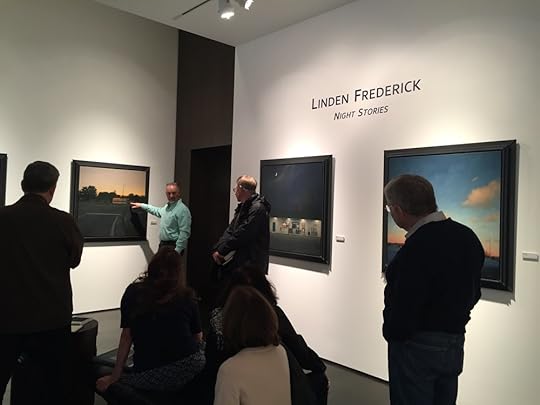
Linden's artist talk.
A really charged moment occurred on Saturday--a good crowd of fans and artists had gathered to hear Linden's artist talk. While Linden spoke about the details of Liquor, the painting that inspired "American Rye Whiskey" by legendary screenwriter Lawrence Kasdan, Lawrence praised him for being able to capture the light at dusk, so fleeting, beloved by artists and filmmakers (and writers.) They had a really fascinating exchange about light, time, film, and art. The crowd was transfixed.
I hope you can see this extraordinary exhibit (May 11-June 30, 2017) and read the book. I feel so privileged to be part of it and thank Linden for his his work, all of it, incandescent and deeply inspiring.
May 11, 2017
Chapter X
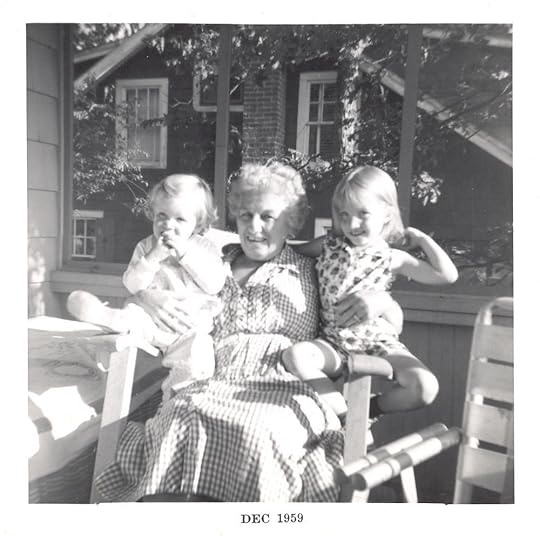
from L-R: middle sister, Mim, older sister, on the porch at Hubbard's Point. Our youngest sister wasn't with us yet; she was born the next January.
I write a lot about sisters. I am the oldest of three, and when we were young, we were so close we never wanted to be apart. We shared a bedroom--three beds, three desks, three bookcases, and us.
Sleep didn't come easily because we'd be talking, laughing until we hurt, jumping on our beds and playing hub-a-bub, a game we invented, or telling "Kathlene Stories," an ongoing made-up-on-the-spot series involving a curly-haired older neighbor who wore silk print shirtwaist dresses and referred to herself as "a maiden lady." We improvised the pitfalls and perils of Kathlene and her sidekick, a French poodle named Coquette. Our protagonist had a tender, easily-bruised heart, strong opinions, and a steely inner strength, somewhere between Jane Eyre and a character, whose name now escapes me, on The Doctors, thr soap opera we watched.
If I called my middle sister right now, I bet she could tell me the name of that character. She'd probably say it with an English accent like Colin Wakefield, a handsome doctor on the show. Or she'd growl like Billy Aldrich, the bad boy played by Alec Baldwin. Speaking in character is something she'd do--it was one of our ways of communicating, part of our secret language. But I can't call her. She's not there.
She's lost to me. That sounds like a line from The Doctors--dramatic, said with the back of the hand pressed to the brow, tears welling. But it's true. She is alive and, I hope, well, and she lives just a few miles from me and our youngest sister, but she doesn't want to be in our lives. It started a long time ago, and I have no doubt she has a list of reasons for why she doesn't speak to us, want to get together, want to talk and figure this out. I've emailed her from a bunch of different email addresses because every time I do she blocks me and I have to try a new one.
After a while, you stop and wonder. I mean, what's the point, if every time you write, you get the alert that you've been blocked? After a while, is it rude to disrespect her clearly stated desire that she wants nothing to do with you? Or do you follow your heart, hope that this time will be different, that this time your message will get through? You've wracked your brain for ways to circumvent the email situation: call her phone. But the number has been changed. Write her a letter. But she's moved, and although you've heard from friends and cousins the town she now lives in, you don't know the address.
She has her point of view. I don't know what she's saying, lately, about why I'm horrible. That story has changed along the way; it's been layered and layered with infractions. Yet a decade ago we had a very brief and shining thaw, when whatever was wrong melted away. No more hurt, no more anger--our sisterly love was there as strong as ever. We called each other every day--our old closeness was back. When I say I'd have done anything for her, I meant it. Then I tried a little too hard to help with something she didn't think needed helping and maybe that's what drove her away. Maybe I touched a nerve.
See, I have a point of view too. I want to talk to her, explain, hear whatever she has to say to me. I want us to heal this, but how is that possible without actually seeing each other? Without speaking? Will we go through the rest of our lives living ten miles apart, never visiting or talking again?
I can't say I've made peace with the situation, or that I'm okay with it. But the feeling of missing her is so deep--the teetering between frustration and anger, helplessness and sorrow at the passage, the waste of time--the only way to live with all is to practice mindfulness, lovingkindness meditation toward her, toward us. It eases the bottomless grief.
People hear that we're estranged--I hate that word--and they want to bring us back together. They'll say to me, as if I'd never considered it, that life is too short to go through it being mad/upset/stubborn/intractable regarding my sister. That it's time to bury the grievance, whatever it is. I listen, my stomach tight, and nod as if I think they're wise. I blurt out the story of what happened--tell my side of it. I tell the well-meaning friends or distant family members that my door is open. I'd love to have my sister in my life, it's her choice to have this distance.
I think I'm going to stop telling them that or anything. This is between us--the three of us--the sisters. It's pain that belongs to no one else, and I can't expect anyone to understand something that I can't comprehend myself. Just yesterday a friend at a local shop told me she'd seen her. That my sister had said of me and our other sister "We're not in touch." My friend told me this hesitantly, with sensitivity. She wondered how it could be, and I don't blame her, or anyone, for wondering that, for wanting us to reconcile. I nearly fell all over myself trying to explain. When I left the shop, I felt exhausted and a little sick. It is a story I'm so tired of telling, justification I've stopped being able to bear.
My sister loves A.A. Milne. Back during that glimmering time when we were close again, she gave me a copy of one of our favorite Pooh books. The inscription, in her tiny, perfect, dear handwriting said Rusty urges you to pay SPECIAL attention to Chapter X. Rusty was one of our imaginary characters, a key part of our secret language. The chapter contained a message from my sister to me, and as soon as I read it, I understood.
So, now, my message to her: Call or write me. My phone number and email address are the same. I love you. And Rusty STRONGLY urges you to pay SPECIAL attention to Chapter X.
May 8, 2017
Goodreads Giveaway of THE BEAUTIFUL LOST
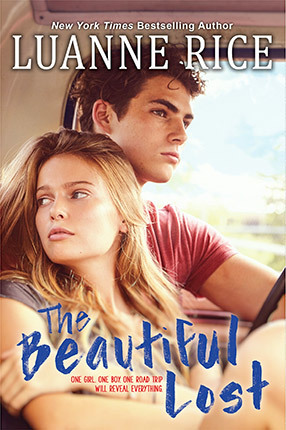
I’m so pleased to announce that Goodreads is hosting a giveaway for THE BEAUTIFUL LOST! Go here to enter to win a bound galley: http://bit.ly/2pZt6Fc @ireadya

April 20, 2017
Two Walks Through Town
Recently I walked down Lyme Street in the early evening. Spring is just beginning, and the first peepers had started to call from the Lieutenant River. The sky was spellbinding a shade of blue so dark and clear it made me look up for a long time, until the moon rose. Some of Old Lyme's graceful houses and galleries had their lights on, glowing warmly from within.

The Cooley Gallery
I passed the Cooley Gallery, my favorite art gallery in the world. Many years ago Jeff introduced me to the work of Linden Frederick, an artist whose paintings, mostly nocturnes, are as luminous as a clear night's sky in early spring. Each tells a story. The gallery also shows Maureen McCabe, my former art professor at Connecticut College, an artist whose intricate collages weave together magic, symbolism, Irish legends, French history, fortune-telling, standing stones, and much more. Each December the gallery holds the beloved All Paintings Great and Small exhibit, incorporating deliciously small works by many of its artists. I never miss it.
Stars had just started to appear, and I tried to capture a photo of them with my iPhone. You can see them just above the old church. It's a private house now, but once it was Christ the King. My parents were married there and both their funerals, separated by years, were held there. When i walk past, i silently thank the building for being the keeper of timeless joy and sorrow.

I took another recent walk on a rainy day. Lyme Street is as beautiful in daytime, all through the year, in any weather. It's April, so I visited the daffodil field. In full bloom behind its classic wrought iron fence, I stopped to look, to feel the essence of spring in Old Lyme. There was something all-the-more enchanting, seeing it on a gray day, with mist falling and scraps of fog blowing in from the river. Standing there, it took me back in time, made me forget the year, the century, let me feel the beauty and history of this place where I'm lucky enough to live.

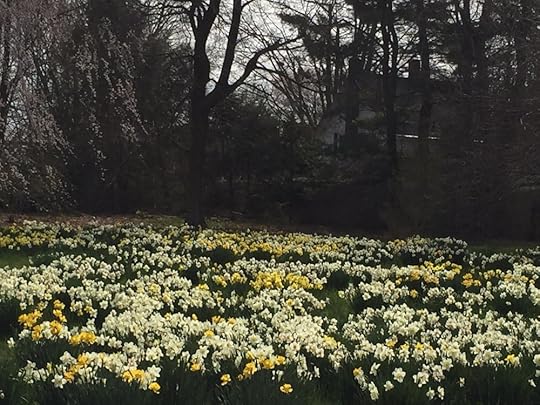
March 15, 2017
Kirkus Review for THE BEAUTIFUL LOST

Emelina and THE BEAUTIFUL LOST
I'm so thrilled by this wonderful review from Kirkus!
KIRKUS REVIEWIt’s been six years since Maia’s mother left and one year since she was hospitalized for attempting suicide. The depression is starting to set in again, but this time she has The Plan.
Eighteen-year-old Maia is determined to find her mother. The young white woman has no problem saying goodbye to her father or even her best friends, but leaving Billy, her longtime crush, proves more difficult. She risks a meeting, thinking if she can just see him one more time, she’ll be able to leave. But Billy is just as unwilling to lose her, offering to run away with her. He knows how to disappear, telling her that cellphones are out, but good music and snack foods are a must. Maia finds herself falling in love with the freckled white boy. And when everything starts falling apart, losing him seems like just one more thing she cannot bear. Veteran Rice pens a riveting examination of the ravages of depression and loss. Both Maia and Billy are well-formed and complicated, and their progression from acquaintanceship to love will tug at even the most jaded hearts. An author’s note and resources serve as encouragement for those battling their own pain.
This novel clearly demonstrates that sometimes it is only in darkness that one can see light. (Fiction. 12-16)
Pub Date: June 27th, 2017
ISBN: 978-1-338-11107-1
Page count: 304pp
Publisher: Point/Scholastic
Review Posted Online: March 6th, 2017
Kirkus Reviews Issue: March 15th, 2017



